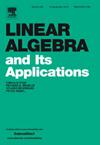Sign patterns of semimonotone matrices
IF 1.1
3区 数学
Q1 MATHEMATICS
引用次数: 0
Abstract
A real matrix A is called a (strictly) semimonotone matrix if for any nonnegative nonzero vector x, there exists an index k such that is positive and is (positive) nonnegative. A sign pattern matrix (or sign pattern) S is a matrix with entries from the set . The paper aims to study the sign pattern S that allows (strictly) semimonotonicity (if there exists a (strictly) semimonotone matrix with sign pattern S) or requires (strictly) semimonotonicity (every matrix of sign pattern S is (strictly) semimonotone), and to discuss a few algebraic properties of semimonotone matrices. In particular, we provide characterizations of sign pattern matrices that allow strictly semimonotonicity. We also present a necessary and sufficient condition for a sign pattern to require semimonotonicity and strictly semimonotonicity. Furthermore, we show the existence of a basis of , consisting of semimonotone and strictly semimonotone matrices. At last, we characterize rank one semimonotone and strictly semimonotone matrices.
半单调矩阵的符号模式
实矩阵A称为(严格)半单调矩阵,如果对于任何非负非零向量x,存在一个指标k使得xk为正且(Ax)k为(正)非负。符号模式矩阵(或符号模式)S是一个矩阵,其条目来自集合{+,−,0}。本文旨在研究允许(严格)半单调(如果存在一个(严格)半单调矩阵具有符号模式S)或要求(严格)半单调(每个符号模式S的矩阵都是(严格)半单调)的符号模式S,并讨论了半单调矩阵的几个代数性质。特别地,我们提供了允许严格半单调的符号模式矩阵的刻画。给出了符号模式要求半单调性和严格半单调性的充分必要条件。进一步,我们证明了由半单调矩阵和严格半单调矩阵组成的Rn×n基的存在性。最后,我们刻画了秩一半单调矩阵和严格半单调矩阵。
本文章由计算机程序翻译,如有差异,请以英文原文为准。
求助全文
约1分钟内获得全文
求助全文
来源期刊
CiteScore
2.20
自引率
9.10%
发文量
333
审稿时长
13.8 months
期刊介绍:
Linear Algebra and its Applications publishes articles that contribute new information or new insights to matrix theory and finite dimensional linear algebra in their algebraic, arithmetic, combinatorial, geometric, or numerical aspects. It also publishes articles that give significant applications of matrix theory or linear algebra to other branches of mathematics and to other sciences. Articles that provide new information or perspectives on the historical development of matrix theory and linear algebra are also welcome. Expository articles which can serve as an introduction to a subject for workers in related areas and which bring one to the frontiers of research are encouraged. Reviews of books are published occasionally as are conference reports that provide an historical record of major meetings on matrix theory and linear algebra.

 求助内容:
求助内容: 应助结果提醒方式:
应助结果提醒方式:


